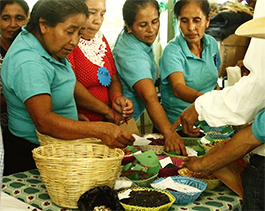Interview with the coordinating team of the Coffee System project, which aims to assess diversification strategies among small-scale coffee farmers in Central America.

What are the main highlights/outcomes of your project?
Agroecology is a whole systems approach that connects environmentally sound production to food security, resilience, income stability, and strong social organization, ultimately providing pathways to the sustainability of the entire food system. Diversity is a major principle within agroecology-based transitions, informing efforts to manage risk, enhance soil fertility, optimize productivity, generate alternative income streams, and improve diets. Our project focused on how farm and livelihood diversification could help improve the situation of smallholder coffee farmer households. More specifically, we sought to address gaps in the scientific understanding of the opportunities and challenges associated with smallholder and food system diversification. We worked through a consortium of institutions dedicated to co-producing knowledge and developing strategies to navigate high-risk Mesoamerican environments and shifting market conditions in the coffee value chain.
Seasonal food insecurity remains a persistent challenge for smallholder coffee farmers in Mexico and Central America. According to results from our baseline household (HH) survey in 2017 (174 HH in Nicaragua and 167 HH in Mexico), farmers reported an average of 2.5 food insecure months (‘thin’ or ‘lean’ months) per year in Mexico, while in Nicaragua the average was lower, at 1.6 months. In addition to recurrent food insecure or lean months common to rural communities worldwide, studies have shown that over 2 billion people fail to eat a sufficiently diverse diet. Our participatory research in Nicaragua found fewer lean months in 2017 than in previous years, while regression analysis revealed a strong, significant positive correlation between dietary diversity (DD) and farm diversity, a positive relationship between DD and total income, and a negative correlation between DD and the number of lean months. Evidence from Mexico show that as total farm size, land under coffee, and volume of coffee produced increased, the number of thin months reported by the participants decreased. The results further suggest that coffee farmers growing corn and/or beans, experienced, on average, fewer months of food scarcity than farmers who did not produce staple crops, although they were generally more food insecure than farmers who produced honey in addition to coffee and staple crops. All of these relationships are in the expected directions; more on-farm diversity, as well as higher incomes, often contributes to the production and purchase of more diverse foods, while more thin months is an indicator of food insecurity and is more likely to be correlated with reduced dietary diversity as a coping response.
In both Nicaragua and Mexico, we analyzed income, food security and other variables across strata of diversification levels (how many activities the household managed, including 1) just coffee, 2) coffee plus home-garden, 3) coffee plus home-garden and 4) bee-keeping). The analysis across these groups found that beekeepers had significantly better incomes than most of the other groups. In Mexico, this was measured using the original ranking of reported income sufficiency. In Nicaragua, our analysis shows that beekeepers had significantly higher average gross incomes when compared with all other diversification groups with the exception of the Home Garden/Most Diversification Group. Comparisons between groups detected a difference in gross income between Beekeeping and Specialized Coffee, Beekeeping and Diversified Coffee, and Beekeeping and Milpa. In Mexico, we found that beekeepers appeared to perceive their income as sufficient more frequently than farmers who did not practice beekeeping. The results further indicate that farmers combining beekeeping with staple crop production had the highest probability of perceiving their income as ‘sufficient’. These findings, in both countries, complement agricultural calendars we have created for each context, which already show that honey production can generate income during critical lean months. In the case of Nicaragua, women have increasingly started beekeeping operations, and it appears that while there are risks, this has supported their incomes and sense of autonomy. Beyond connections between beekeeping and income and gender dynamics, we are also exploring important benefits associated with higher levels of diversification and beekeeping, as a way to reach desired ecological and socioeconomic goals. Examples of these benefits include pollination as an ecosystem service and the conservation of important agrobiodiversity (e.g. corn landraces, wild edible plants, etc.).
In what way is your project (and/or your approach) innovative?
Our project uses a Participatory Action Research (PAR) approach, grounded in the belief that the data we collect will be more accurate and better suited for finding solutions, if researchers and farmers work together to maximize our diversified expertise. This means some team members may specialize in specific content areas, while others have deep knowledge of the local context and landscape. What is vital to the PAR process is that we work together to find synergies that lead to a more complete and contextualized understanding. To achieve this within our project, has required an intentional, deliberate ethic of inclusion and cross-fertilization of knowledge at every stage. This began with input from the coffee cooperatives about research questions, and the design of the initial survey instruments for our Phase 1 data collection in 2017. It has continued throughout the project, including our current virtual meetings to validate results, and our efforts to best convert findings so that they inform decisions at the individual, community and cooperative (co-op) levels. Monthly visits to households in selected communities within each country has produced a robust data set that will allow for analysis of change over time, instead of basing assessments on a single visit, or a pre/post data collection cycle. We were initially concerned that the households would lose interest, but in many cases the PAR process has piqued interest in further experimentation and identification of new areas of potential research. PAR processes like this one, which usually result in strong co-creation of knowledge among participants, emphasize the importance of evidence that responds to ‘real life problems’ and is actionable.
One of the most successful components of this PAR process were the two cross-site educational exchanges. In November of 2018, 150 participants (including academics, NGO representatives, farmers, community researchers and co-op representatives from Nicaragua, Mexico and the U.S.), took part in a week-long immersion experience in Nicaragua that included dialogue, analysis of results, field visits to farms and cooperative installations, and hours of comparative conversations (described here, pp.38-45). “Work in one place impacts the other side of the world,” Misael (a PRODECOOP agronomist) noted in his reflection on the experience of hosting delegates from Mexico and the US at PRODECOOP. “We are not alone” he added. In August of 2019, the process was repeated with a week-long immersion in Mexico (described here, pp. 36-42), which included nearly 100 participants. “When I went to Nicaragua, I saw many things I shared with everyone here in Mexico,” said Leticia Velasco López, a member of CESMACH’s board of directors. She added “I think the same was true of our colleagues from Nicaragua. They saw coffee fields planted with vegetables and for me it was motivating to see what CESMACH’s members were already doing.”
Managing seven organizations with different styles and agendas, amidst political upheaval and a pandemic has proven challenging. However, the relationships and trust that we have developed as a function of our PAR approach leaves us in a strong current position as we work in remotely, in our diverse teams, to complete our final project deliverables. This has enabled the full project team to develop a research design that reflects priorities and perspectives of our partners within the two coffee cooperatives, and is grounded by the traditional foodways and knowledge systems of smallholder farmers. This process is slower than a more conventional process where the instruments are designed without consensus. Recognizing this, we remain convinced that if we are looking for viable solutions to ‘wicked problems’, we must adapt to the pace and dynamics of the local context. Or, in the words of one of our Mexico-based research team members, we must remember - ‘You can’t dance faster than the music.’

Martha Caswell assumes the Co-Directorship of the University of Vermont’s Agroecology and Livelihoods Collaborative (ALC)